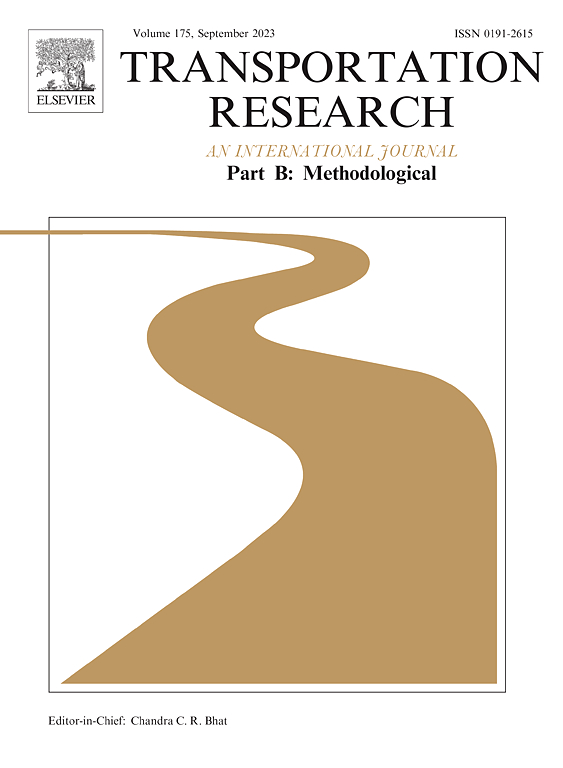面向人机协同交通规划的城市动态可解释状态空间模型
IF 5.8
1区 工程技术
Q1 ECONOMICS
引用次数: 0
摘要
战略远程交通规划(SLRTP)对于塑造繁荣、可持续和有弹性的城市未来至关重要。现有的SLRTP决策支持工具主要服务于预测和评估功能,在直接推荐最佳规划决策方面留下了空白。为了弥补这一差距,我们提出了一个可解释的状态空间模型(ISSM),该模型考虑了交通基础设施和更广泛的城市系统之间的动态相互作用。ISSM直接促进了优化基础设施投资和城市政策的最优控制器和强化学习(RL)代理的开发,同时仍然允许人类用户理解。我们仔细检查了ISSM的数学性质;具体地说,我们给出了我们所提出的ISSM是马尔可夫的,并且存在唯一且稳定的解的条件。然后,我们将ISSM实例应用于加州圣地亚哥地区的案例研究,其中部分可观测的ISSM代表了城市环境。我们还使用代表圣地亚哥的ISSM实例提出并训练了一个深度强化学习代理。结果表明,拟议的ISSM方法与训练有素的RL代理一起,捕捉到了协调基础设施投资时机、新土地开发的环境影响费和拥堵定价费的影响。结果还表明,该方法促进了SLRTP规范能力的发展,以促进经济增长和限制诱导车辆旅行。我们认为拟议的ISSM方法是支持在城市规划中使用人工智能的重大贡献,在这个领域,规划机构需要严格、透明和可解释的模型来证明他们的行动是合理的。本文章由计算机程序翻译,如有差异,请以英文原文为准。
Interpretable State-Space Model of Urban Dynamics for Human-Machine Collaborative Transportation Planning
Strategic Long-Range Transportation Planning (SLRTP) is pivotal in shaping prosperous, sustainable, and resilient urban futures. Existing SLRTP decision support tools predominantly serve forecasting and evaluative functions, leaving a gap in directly recommending optimal planning decisions. To bridge this gap, we propose an Interpretable State-Space Model (ISSM) that considers the dynamic interactions between transportation infrastructure and the broader urban system. The ISSM directly facilitates the development of optimal controllers and reinforcement learning (RL) agents for optimizing infrastructure investments and urban policies while still allowing human-user comprehension. We carefully examine the mathematical properties of our ISSM; specifically, we present the conditions under which our proposed ISSM is Markovian, and a unique and stable solution exists. Then, we apply an ISSM instance to a case study of the San Diego region of California, where a partially observable ISSM represents the urban environment. We also propose and train a Deep RL agent using the ISSM instance representing San Diego. The results show that the proposed ISSM approach, along with the well-trained RL agent, captures the impacts of coordinating the timing of infrastructure investments, environmental impact fees for new land development, and congestion pricing fees. The results also show that the proposed approach facilitates the development of prescriptive capabilities in SLRTP to foster economic growth and limit induced vehicle travel. We view the proposed ISSM approach as a substantial contribution that supports the use of artificial intelligence in urban planning, a domain where planning agencies need rigorous, transparent, and explainable models to justify their actions.
求助全文
通过发布文献求助,成功后即可免费获取论文全文。
去求助
来源期刊
CiteScore
12.40
自引率
8.80%
发文量
143
审稿时长
14.1 weeks
期刊介绍:
Transportation Research: Part B publishes papers on all methodological aspects of the subject, particularly those that require mathematical analysis. The general theme of the journal is the development and solution of problems that are adequately motivated to deal with important aspects of the design and/or analysis of transportation systems. Areas covered include: traffic flow; design and analysis of transportation networks; control and scheduling; optimization; queuing theory; logistics; supply chains; development and application of statistical, econometric and mathematical models to address transportation problems; cost models; pricing and/or investment; traveler or shipper behavior; cost-benefit methodologies.

 求助内容:
求助内容: 应助结果提醒方式:
应助结果提醒方式:


